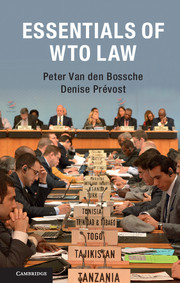Book contents
- Frontmatter
- Contents
- List of figures and tables
- Preface
- List of abbreviations
- Table of cases
- 1 International trade and the law of the WTO
- 2 Rules on non-discrimination
- 3 Rules on market access
- 4 Trade liberalization and other societal values and interests
- 5 Rules on unfair trade
- 6 Rules regarding harmonization of national regulation
- 7 The institutional aspects of the WTO
- 8 The WTO dispute settlement system
- Online resources
- Index
- References
3 - Rules on market access
- Frontmatter
- Contents
- List of figures and tables
- Preface
- List of abbreviations
- Table of cases
- 1 International trade and the law of the WTO
- 2 Rules on non-discrimination
- 3 Rules on market access
- 4 Trade liberalization and other societal values and interests
- 5 Rules on unfair trade
- 6 Rules regarding harmonization of national regulation
- 7 The institutional aspects of the WTO
- 8 The WTO dispute settlement system
- Online resources
- Index
- References
Summary
Introduction
Secure and predictable access to markets is essential for international trade. However, access for goods and services from other countries to the market of a WTO Member is frequently impeded or restricted in various ways. These restrictions can be in the form of either tariffs or non-tariff barriers to trade. The most common tariff barriers to trade are – at least for goods – customs duties. Tariff barriers to trade can also take the form of other duties and charges on imports and exports. Non-tariff barriers to market access – for goods as much as for services and service suppliers – comprise:
• quantitative restrictions, such as quotas and bans; and
• other non-tariff barriers, such as technical barriers to trade, lack of transparency of national trade regulation, unfair and arbitrary application of national trade regulation, customs formalities and procedures and government procurement practices.
Different WTO rules are applicable to these various tariff and non-tariff barriers to market access. This different treatment reflects a difference in the economic impact of these trade barriers.
Customs duties and other duties and charges on imports
A customs duty, or tariff, on imports is a financial charge or a tax on goods, due because of their importation. Market access for the goods concerned is conditional upon the payment of the customs duty. Most customs duties on imports are ad valorem (i.e. a percentage of the value of the imported product).
For example, the customs duty of Agricola on imports of chocolate bars is 12 per cent ad valorem. Therefore, the importation of chocolate bars to the value of €10000 will be subject to a customs duty of €1200.
Customs duties may also be specific, that is based on a unit of quantity such as weight (kg), length (m), area (m2), volume (m3 or l) or numbers (pieces, pairs, dozens or packs) of that product. Some customs duties are a combination of ad valorem and specific duties and are called compound or mixed customs duties.
For example, Industria applies a duty of €1 per kilogram of imported chocolate and a duty of €30 on each imported smartphone. Both of these are specific customs duties.
- Type
- Chapter
- Information
- Essentials of WTO Law , pp. 49 - 82Publisher: Cambridge University PressPrint publication year: 2016



